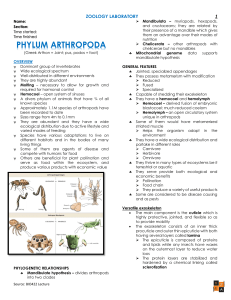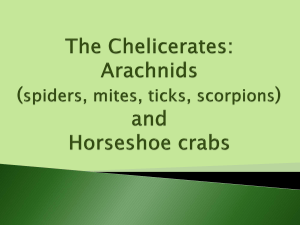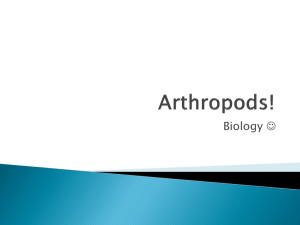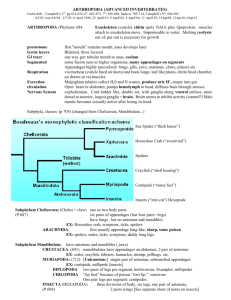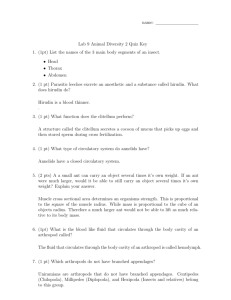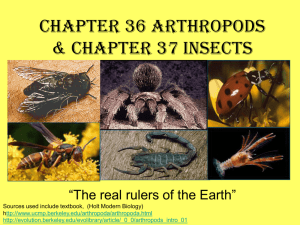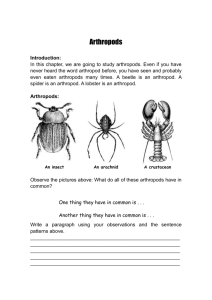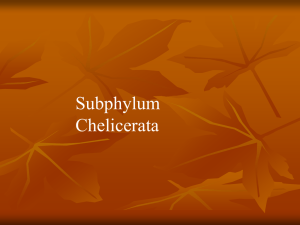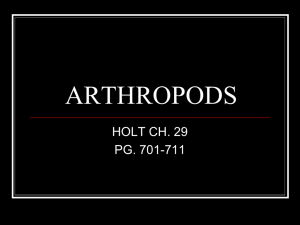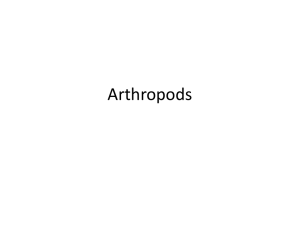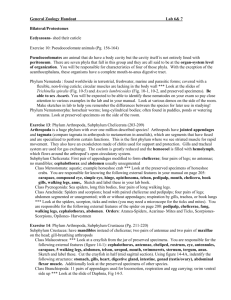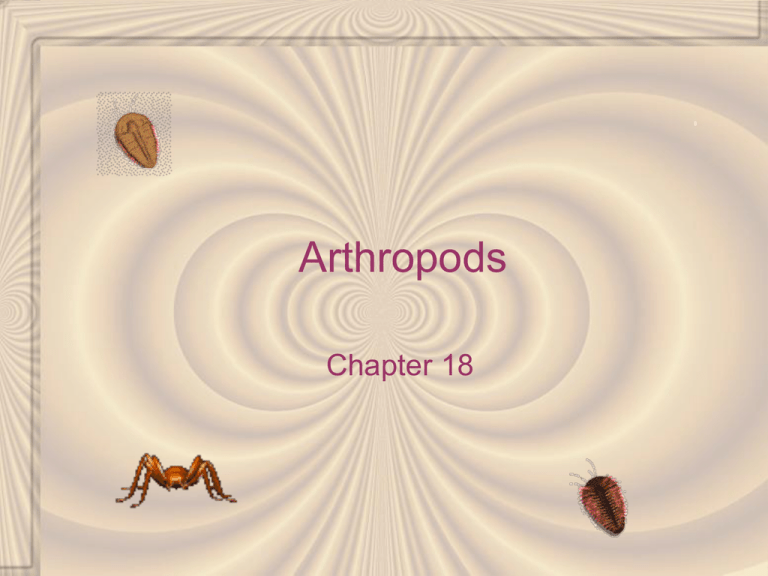
Arthropods
Chapter 18
I. Phylum Arthropoda
¾ of all known animal species; abundance and wide
ecological distribution makes them most diverse
group
Dates from late Precambrian
Distinct metameres: linear somites with jointed
appendages; somites may be fused or combined
into specialized groups called tagmata; appendages
specialized for division of labor
Size ranges from 0.1 mm to 4 m
All modes of feeding are used but most herbivorous
II. Body Plan
A. Exoskeleton
Cuticle protective but jointed for mobility; inner thick
procuticle and outer thin epicuticle
Consists of chitin bound with protein making a
lightweight, flexible barrier that protects against
dehydration
Laminated and tanned making it harder
Thins at joints to allow movement
Infolds to line foregut, hindgut, and trachea
Ecdydis, molting, sheds outer covering and growing
new, larger one; exocuticle secreted by procuticle
prior to molt and endocuticle secreted afterwards.
Arthropods molt 4-7 times, with weight of
exoskeleton the ultimate limit of size of animal
B. Segmentation & Appendages
Each somite bears pair of segmented legs
Segments and appendages modified for various
adaptive functions such as food handling,
sensing, walking, or swimming
Limb segments are hollow levers with internal
striated muscles
C. Respiration
Tracheal system
efficiently delivers
oxygen to cells in
terrestrial arthropods
Gills are used by
aquatic arthropods
D. Sense Organs
Eyes vary from simple ocelli to a compound
mosaic eye
Other senses are used for touch, smell, hearing,
balancing, and chemical reception
E. Behavior
Surpass most other
invertebrates in
complex and
organized activities
Most behavior innate
but some is learned
F. Metamorphoses
Most undergo
metamorphoses that
result in different larval
and adult forms
Larval and adult forms
occupy different
habitats and eat
different foods to avoid
competing with each
other
III. Subphylum Trilobita
Arose before Cambrian, flourished, died out 200 mya
Trilobed body shape; head, thorax, pygidium
Head fused segments; bore compound eyes, antennae, mouth,
and jointed appendages
Gills
Bottom dwellers; probably scavengers
2- 67 cm long; could roll up like pill bugs
IV. Subphylum Chelicerata
A. General Features
Six pairs of
appendages:
chelicerae (most
anterior on head),
pedipalps (2nd pair),
and 4 pairs of legs
No mandibles or
antenna
Most suck liquid from
prey
B. Class Merostomata
Horseshoe crabs; unchanged since Triassic
5 species
Unsegmented carapace covers body; 2 compound eyes and 2
simple eyes
Cephalothorax bears 1 pair chelicerae and 5 pairs of walking
legs
Abdomen bears book gills on appendages in median line
Larvae resemble trilobites
C. Class Pycnogonida
Sea spiders
Many have chelicerae
and palps; 5-6 pairs of
legs
Proboscis sucks fluids
from cnidarians and
other soft-bodied
marine organisms
Live in all oceans but
more common in polar
D. Class Arachnida
1. General Features
Spiders, scorpions, daddy longlegs, ticks, and
mites; over 70,000 species
Live mainly in warm dry regions
Body consists of cephalothorax (chelicerae,
pedipalps, 4 pairs of walking legs) and abdomen
Predaceous with claws, fangs, poison glands, or
stingers
Sucking mouth parts ingest fluids and soft
tissues
Most harmless and control undesirable insects
2. Order Araneae: Spiders
a. Feeding
Pair chelicerae with
terminal fangs
Pedipalps help handle
food
All spiders predaceous,
feeding mainly on
insects which are killed
with poison and fangs
Injected venom liquefies
and digests the tissues;
sucked into stomach
b. Respiration
Book lungs or tracheae used
Book lungs unique to spiders; parallel air pockets
extend into blood-filled chamber; air enters
chamber through lit in body wall
Tracheae are tubes that carry air from the inside
directly into the tissues
c. Excretion
Malpighian tubules are used for excretion
Potassium, other solutes, and wastes are
secreted into tubules
Rectal glands reabsorb the potassium and water,
leaving wastes and uric acid for excretion; this
conserves water allowing spiders to live in dry
environments
d. Sensory Systems
Most have 8 simple
eyes, each with a
lens, optic rods, and a
retina; used to detect
movement and may
form images
Sensory setae detect
air currents, web
vibrations, and other
stimuli
e. Web-spinning
Spinning silk critical
ability
2-3 pairs of spinnerets
contain tubes that go to
silk glands
A liquid protein hardens
as it is extruded; the
silk is very strong and
will stretch
considerably before
breaking
Silk is used for webs,
lining burrows, forming
egg sacs, and wrapping
prey
f. Reproduction
Male stores sperm in
pedipalps before mating
A courtship ritual is
required by female
Male inserts pedipalps
into female genital
openings
Eggs develop in a
cocoon in the web or
may be carried by the
female
Young hatch in 2 weeks
g. Harmfulness
Spiders consume undesirable
insects
American tarantulas rarely bite
and bite is not dangerous
Some black widow spiders are
venomous to humans, being
neurotoxic
Brown recluse spider has
hemolytic venom that destroys
tissue around bite
Some Australian and South
American spiders are the most
dangerous and aggressive
3. Order Scorpionida: Scorpions
a. Features
Most common in tropical and subtropical areas
Nocturnal and feed largely on insects or spiders
Sand scorpions detect prey by feeling surface
waves with leg sensillae
Cephalothorax has appendages, medial eyes,
and 2-5 lateral eyes
Preabdomen has 7 segments
Postabdomen has tail that ends in a stinger
Stinger has venom that varies from mildly painful
to dangerous
b. Reproduction
Comblike pectines
under abdomen are
used in sex
recognition
During mating dance,
male guides female
over spermatophore
Ovoviviparous or
viviporous producing
6-90 young
4. Order Opiliones:Harvestmen
Daddy long legs
Common in tropical regions
Cephalothorax and abdomen join broadly without
any narrowing as in spiders
Chelicerae are pincer-like and used for scavenging
5. Order Acari: Ticks and Mites
a. Features
30,000 species
All environments
Fusion of cephalothorax
and abdomen with no
external segmentation
Mouth on end of tube
Chelicerae pierce, tear,
or grip food
pedipalps, and 4 pairs
of legs
Hatchlings are 6-legged
larvae, followed by 8legged nymphal stage
b. Relationship with Humans
House dust mites are free-living and often cause
allergies
Spider mites suck out plant nutrients and is common
agricultural pest
Chiggers are larval mites that feed on skin and cause
rashes
Hair follicle mite is harmless but others can cause
mange in domestic animals
Human itch mite causes intense itching
Ticks may transmit Lyme disease, Rocky Mountain
spotted fever, or Texas cattle fever

